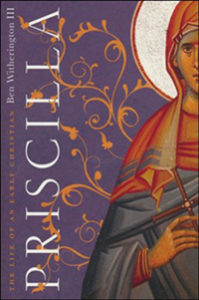Review: Priscilla: The Life of an Early Christian
Priscilla: The Life of an Early Christian
By Ben Witherington III (IVP Academic)
 Ben Witherington III’s Priscilla: The Life of an Early Christian combines biblical scholarship and imaginative storytelling in a way that brings the stories of the New Testament to life.
Ben Witherington III’s Priscilla: The Life of an Early Christian combines biblical scholarship and imaginative storytelling in a way that brings the stories of the New Testament to life.
The book is told from the perspective of Priscilla (or Prisca, as is her nickname) who is mentioned several times in the New Testament (Acts 18:2, 18, 26; Romans 16:3; 1 Corinthians 16:19; and 2 Timothy 4:19) alongside her husband Aquilla as co-workers of Paul.
The New Testament describes Priscilla and Aquilla, always with her name first, as Jewish Christians who lived in Rome before being kicked out of the city by the Emperor Claudius. Paul first met the couple in Corinth and then traveled with them to Ephesus before leaving them there to continue his work.
Witherington takes the sparse details in the biblical narrative and fills in the story based on historical and archaeological sources about life in the first century, with special attention to both Jewish believers in Christ and Gentile believers. Though sometimes sparse, Witherington provides footnotes and biblical references to help the reader understand how he is connecting various events. The result is certainly a work of fiction, but its details are quite plausible.
In the book, Priscilla is an 80-year-old woman who is retelling the stories of her adventures to her adopted daughter Julia. She tells Julia of her visit to Jerusalem for Pentecost where she hears Peter’s preaching and begins following Christ. Then, she reminiscences about many occurrences in her life including meeting Aquilla, becoming married, their expulsion from Rome, challenges they faced while living among the believers in Corinth, their ministry and teaching in Ephesus, their eventual return to Rome where they witness the great fire of Rome under Nero, and the resultant experiences of the church in Rome including the persecution under Domitian, which Priscilla herself faces in the narrative.
While Witherington certainly takes liberties in some matters that contemporary scholars debate (such as identifying Apollos as the author of Hebrews and postulating that Paul made a journey to Spain after a brief incarceration in Rome), the historical fiction genre allows for these speculations and creates an interesting narrative.
Witherington’s primary specialty is as a New Testament scholar and his interpretations of the lives of Priscilla and other early Christians are noteworthy in this book. Additionally, his prose, though not exceptional, is inviting and provides a friendly structure to introduce readers to many ideas and events that prove enlightening to the reading of Scripture. As long as readers recognize this work’s genre as historical fiction and do not mistake it for history, it is to be commended as an illuminating companion to Paul’s letters.
Meredith Stone
Hardin-Simmons University
Abilene